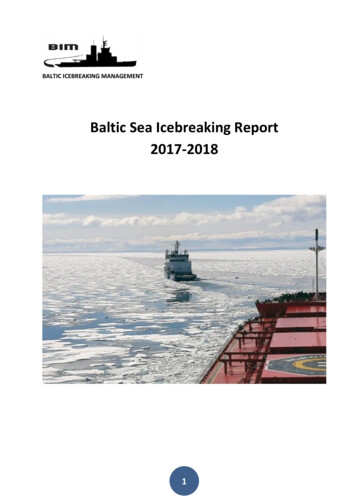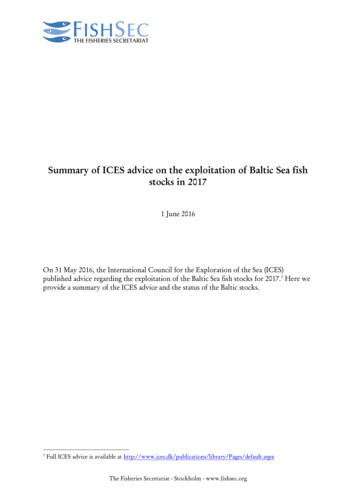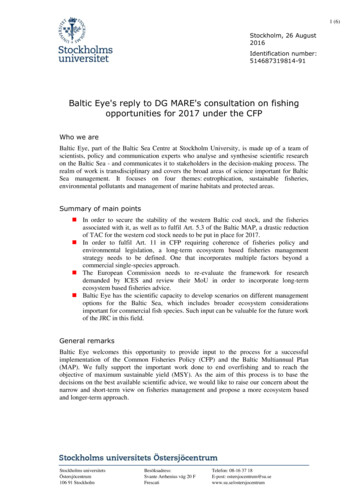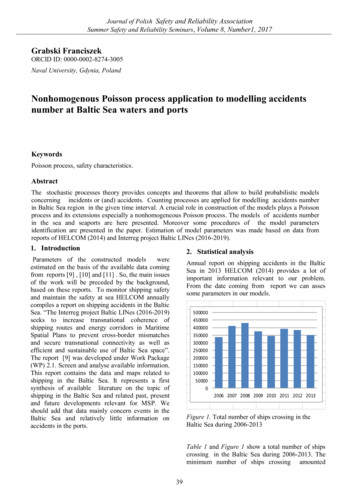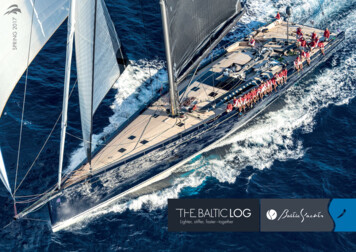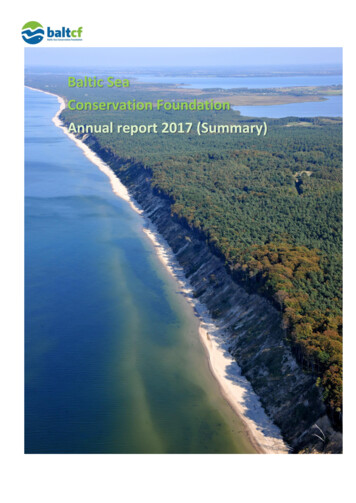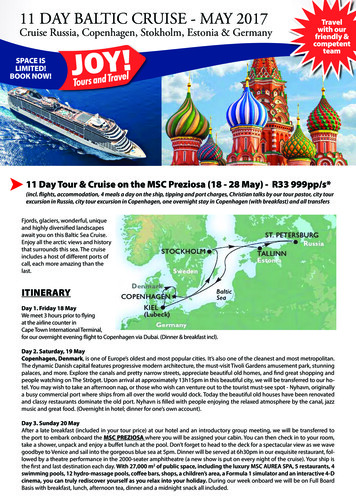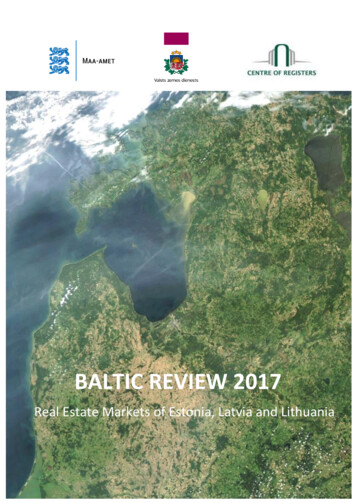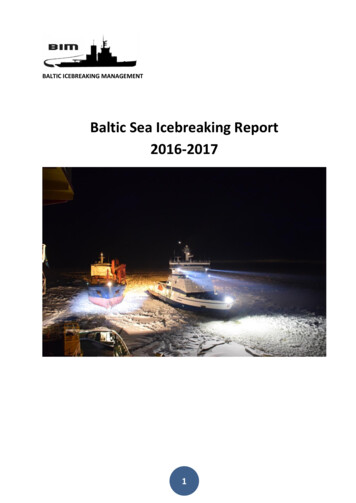
Transcription
BALTIC ICEBREAKING MANAGEMENTBaltic Sea Icebreaking Report2016-20171
Table of contents1.Introduction . 32. Overview of the icebreaking season (2016-2017) and its effect on the maritime transport system inthe Baltic Sea region . 43.Accidents and incidents in sea ice . 104.Winter Navigation Research . 105.Costs of Icebreaking services in the Baltic Sea . 106.1 Finland . 106.2 Sweden . 106.3 Russia . 116.4. Estonia . 116.5 Latvia, Lithuania, Poland and Germany . 116.6 Denmark . 126.7 Norway . 126.Winter navigation in the different parts of the Baltic Sea . 127.1 Bay of Bothnia . 127.2 Sea of Bothnia and the Quark .Virhe. Kirjanmerkkiä ei ole määritetty.7.3 Gulf of Finland . 127.5 Central Baltic . 137.6 Southern Baltic . 137.7 Danish waters, Swedish West coast, Germany and Norwegian waters . 147.Description of organizations and icebreakers engaged during the season 2016-2017 . 158.1 Finland . 158.2 Sweden . 168.3 Russia . 178.4 Estonia . 188.5 Latvia . 188.6. Lithuania . 188.7 Poland . 188.9 Denmark . 198.10 Norway . 198.Progress report of BIM (Baltic Sea Icebreaking Management) . 202
1. IntroductionBaltic Icebreaking Management, BIM is an organization with members from all Baltic Sea states. BIM is adevelopment of the annual meeting between Baltic Sea States icebreaking authorities which haveassembled since 1982. The member countries of BIM are Denmark, Estonia, Finland, Germany, Latvia,Lithuania, Norway, Poland, Russia and Sweden.After the difficult winter navigation season of 2002/2003 a project was started up within the framework ofHELCOM, aiming at improving the safety of winter navigation in the Baltic Sea. The HELCOMrecommendation 25/7 on the safety of Winter Navigation in the Baltic Sea Area was adopted in March2004.Within the EU concept Motorways of the Sea, which is one priority project in the trans-European network,the Baltic Sea countries established a working group with the aim of creating more efficient winternavigation by cooperation between the Baltic Sea countries. The icebreaking authorities around the BalticSea decided at Helsinki meeting 2004 that this work shall continue within the framework of BIM, wherealso non EU-member states are taking part. BIM should function all year round and its strategy should beto develop safe, reliable and efficient winter navigation between the Baltic Sea countries. The overallobjective of BIM is to assure a well-functioning maritime transport system in the Baltic Sea all year roundby enhancing the strategic and operational cooperation between the Baltic Sea countries within the areaof assistance to winter navigation.On 10 January 2007, the Joint Baltic web service on winter navigation www.baltice.org was launched. On17 June 2015, a new version of the Joint Baltic web service on winter navigation was launched.On 11 April 2007, the DVD of training in ice navigation for seafarers was launched.On 15 November 2007, HELCOM adopted a new recommendation 28E/11 outlining further measures toimprove the safety of navigation in ice conditions in the Baltic Sea; BIM was acting an “ice advisor” in thisrecommendation.In 2008 the pamphlet “The World Icebreaker, Icebreaking Supply and Research Vessel Fleet” was presentedand updated in 2011.In April 2009, a computer based training program, based on the DVD, was introduced. After completing thecourse, the student gets a certificate over earned skills. One important task of BIM is to inform stakeholdersin the maritime sector and policy makers about winter navigation and icebreaking. There is a need forinformation about winter navigation and icebreaking that covers the whole Baltic Sea region.Several Baltic Sea countries prepare information about the winter navigation and icebreaking in theirrespective national waters. There has been a need to coordinate this country-specific information, improvethe information and to distribute it to a wider target group by “Joint Annual Baltic Icebreaking Report”.This report gives an overview of the winter navigation season 2016/2017 for the Baltic Sea area. Nationalreports can be found on the site www.baltice.org. The report will also describe organizational changes inthe icebreaking authorities or changes in icebreaking resources and provide a progress report of the BalticSea Icebreaking cooperation and the development of BIM.3
2. Overview of the icebreaking season (2016-2017) and its effect onthe maritime transport system in the Baltic Sea regionAccording to the Finnish Ice Service of the Finnish Meteorological Institute the Baltic Sea ice season 20162017 was mild. The maximum ice extent, 88 000 km², was reached on 12 February.Figure 1. The maximum ice extent of the ice season 2016-2017 was reached on 12 February 2017.4
The freezing started from inner bays of the Gulf of Bothnia in early November. December was exceptionallywarm and at the end of December, the extent of sea ice was only 10 000 km². Icebreaker KONTIO startedher assistance work on 10 December.January began cold but cold weather continued less than two weeks. At the end of January ice extent was44 000 km². Again at the beginning of February the weather was quite cold. The peak of the ice winter wasreached on 12 February, when the ice extent was 88 000 km².Figure 2. The development of ice season 2016-2017 compared to seasons 2006-2016.Then the weather turned mild and the winds became stronger. At the end of February the ice extent was77 000 km². Quickly changing and mild weather continued in March. At the end of March the extent of theice was only 29 000 km².April was colder than usual and ice melting was slow. At the end of April the extent of ice was 15 000 km².Also May was colder than normal and ice melting was very slow – the last icebreaker started her voyagehome as late as on 25 May.Ice conditions in the eastern part of the Gulf of Finland in 2016-2017The ice formation processes in the winter of 2016/2017 were those of a mild winter. Ice formation in thecoastal shallow zone of the eastern part of the Gulf of Finland began in the second decade of November.By mid-December, the entire water surface of the seaport “Big port of Saint-Petersburg” was completelycovered with ice, the thickness of which was from 5 to 20 cm.5
By mid-January due to the lowering of air temperature solid ice with thickness up to 15 cm spread from theCape Shepelevskii to the Western Birch Island and reached Rondo Island. In Vyborg Bay and on the watersof Neva Bay fast ice with thickness from 15 to 40 cm was observed.In February, the area of the ice cover gradually increased. By mid-month the ice edge passed from Toilavillage (Estonia) in the South, through the Western extremity of Powerful Island and Nerve Island to thevillage of Hamina (Finland) on the Northern shore of the Gulf of Finland. By the end of February nilas icehad spread to the Meridian of Hogland Island.In March, air temperatures were noted around zero degrees, the wind blew mainly from the West andSouth-West directions. Under the influence of winds solid ice began to shift to the Northern shore of theGulf of Finland. Ice formation in the Eastern part of the Gulf had slowed, and since the second half of themonth it was to be a gradual destruction and melting of ice. The water area of the port of Ust-Luga wascleared of ice.In April, the ice cover continued to break down. In spite of the fact that air temperatures were below theaverage, the water area of Neva Bay became completely ice free by 10 April. The icebreaking period in theseaport of Ust-Luga was completed on 21 April 2017, and on 25 April 2017 the icebreaking periods in allRussian ports of the Gulf of Finland were completed too.Figure 3. The maximum ice coverage in ice winters 1961-2017. The average of 1961-2011 (51 years) is187 000 km². Severities of the season are indicated using colours from mild to severe (lightest blue todarkest blue respectively).6
The maximum thickness of fast ice was 30-70 cm in the Bay of Bothnia, 30-45 cm in the Sea of Bothnia and25-50 cm in the Gulf of Finland. The thickness of pelagic ice was 40-60 cm in the Bay of Bothnia and 10-35cm in the Gulf of Finland.For safety reasons, the Baltic Sea countries have agreed within HELCOM on a joint policy when trafficrestrictions are issued. For efficiency reasons, the icebreaking authorities can demand a lowest limit onvessels’ engine power as well. Smaller vessels like buoy tenders and tugs with strong engines and hull areused as port icebreakers and for icebreaking mission in waters protected from drifting sea ice. In open seaareas that are affected by drifting sea ice with ridges and ice pressure, big sea icebreakers are required.Total number of icebreakers inoperation in w.17w.18w.19w.20w.21w.22w.230Sea Icebreakers (more than 7500 hp)Other IcebreakersTotal IcebreakersFigure 5. The total number of icebreakers in operation each week in the Baltic Sea during this season.According to statistics from the Baltic Sea icebreaking authorities, 4302 vessels received assistance fromicebreakers this season. These figures can be compared with season 2012-2013, which was an averagewinter, when 7861 vessels were assisted.7
Assisted shipsGulf of Riga; 131Gulf of Bothnia ;1725Gulf of Finland ;2393Sea of Bothnia ;26Figure 6. A total of 4302 vessels where assisted by icebreakers during the icebreaking season 2016-2017 inthe Baltic Sea.8
The longest sailing distance in sea ice is to the northernmost ports in the Bay of Bothnia. But due to the bignumber of vessels in the shorter fairway to the easternmost ports in the Gulf of Finland, the traffic is moreaffected by sea ice in this area, especially during periods with strong westerly winds when the icebreakersmust tow many vessels one by one.Figure 7. Sailing distance from ice edge during maximum ice extension on 12 February 2017: to Kemi202 nautical miles and to St. Petersburg 124 nautical miles.9
3. Accidents and incidents in sea iceThe Technical University of Helsinki collects information on accidents related to navigation in ice. Shipowners and others within winter navigation are requested to report accidents, incidents and damages thatare ice-related to icedamage@tkk.fi or toIce Damage DatabaseHelsinki University of TechnologyShip LaboratoryPL 530002151 TKKFINLANDOnly two incidents were reported this season, one collision and one damaged propeller. In comparison,about 100 vessels reported damages due to the severe ice conditions ten years ago in the year 2003.4. Winter Navigation ResearchWinter navigation research is carried out in co-operation between Finland and Sweden. Funds for researchprojects are allocated by the Winter Navigation Research Board, which consists of representatives of theFinnish Transport Agency, Finnish Transport Safety Agency, Swedish Transport Agency and SwedishMaritime Administration. Published research reports can be found on kaisut/talvimerenkulun tutkimusraportit).5. Costs of Icebreaking services in the Baltic Sea5.1 FinlandIn Finland the stand-by and operational costs of icebreakers were nearly 49.5 million euro in the period2016-2017. Bunker costs were 6.0 million euro. This season was again quite easy but it lasted longer thanthe past two years and the total number of operating days was 620. The Finnish Transport Agency (FTA)had a contract with the Swedish Maritime Administration to charter one Atle-class icebreaker and acontract with Alfons Håkans to charter MSV ZEUS; MSV ZEUS was replaced by MSV THETIS. Theabovementioned costs include all FTA chartered ice breakers. The FTA has also contracts with privatetugboat companies for minor operations. The costs of the Finnish icebreaking services vary normally around60 million euro, depending on the winter.5.2 SwedenIn Sweden the cost for the stand-by period for our own icebreakers is approximately 12 million euro,additional operational costs are 5 million euro, and fuel costs 2.5-9 million euro. The total cost for theSwedish icebreaking services including external recourses varies from 20 to 40 million euro, depending onthe severity of the winters. The costs this winter are estimated to be 24.5 million euro. This is thegovernment's costs; costs for the different ports and industries are not included.10
5.3 RussiaIn accordance with the orders of the FTS of Russia dated 20 December 2007 No. 522-t/1 and 18 November2014 No. 262-t/5, and by order FAS of Russia of 06 June 2016 No. 711/16, new rates of icebreaking dues inthe Russian ports of the Gulf of Finland are established as follows:Icebreaking dues:1. Icebreaking dues are applied for coming in, coming out or transiting the port area.2. For the cargo ships engaged in liner services, which are officially declared, the factor of 0.8 is applied tothe rates of the icebreaking dues.From icebreaking dues are exempted:- vessels of ice class ARC7 (according to classification of the Russian Maritime Register of Shipping or classesof other classification societies corresponding to it);- passenger vessels.Upon the announcement by the Harbour Master of winter (summer) navigation before the target date, andalso after the prolongation of its duration, icebreaking dues are paid as per corresponding rates from thedate of announcement to a date of completion (inclusive), corresponding to the period of winter navigation.Rates for ships engaged in an international trade rub/1 GT (for Bolshoy port of Saint-Petersburg)The summer ratefrom 01 May to 30NovemberThe winter rate from01 December to 30AprilAll vessels exceptRo-Ro,Ro-Flow,container ships andtankers6.65Container shipsRo-Ro, g the period from 01 May to 30 November, the following vessels are exempted from payment oficebreaking dues: arriving at the port from inland waterways of Russia or from the Saimaa canal and sailing back withinthe current year; arriving at the port from other Russian ports situated in the eastern part of the Gulf of Finland.During the period from 01 December to 30 April, the vessels with ice class ARC5 and ARC6 (according toclassification of the Russian Maritime Register of Shipping or classes of other classification societiescorresponding to it) are subject to icebreaking dues multiplied by factor 0.75.5.4. EstoniaIn Estonia, the total cost of icebreaking in the 2016-2017 season amounted to approximately 6 million euro,with about 565 000 euro accounting for the costs in Pärnu Bay and 5,4 million euro for the Gulf of Finland.This is the Governmental costs.5.5 Latvia, Lithuania, Poland and GermanyThere was no cost information for icebreaking operations in the season 2016-2017.11
5.6 DenmarkIn 2016/2017 the cost of the Danish ice service was approximately 0.35 million euro. The reason for this isthat Denmark only operates chartered tugs with icebreaking capacity in four readiness areas, East andWestern Limfjord, the waters south of Funen and Smålandsfarvandet south of Zealand. The chartered tugsare only brought into operation when necessary.5.7 NorwayDuring the winter 2016/17, the total costs of ice breaking service in Norwegian waters wereapproximately EUR 1.0 million.6. Winter navigation in the different parts of the Baltic Sea6.1 Bay of Bothnia, Sea of Bothnia and the QuarkTraffic restrictions where initiated on 10 December in the Bay of Bothnia, theicebreaking operations began on 8 December when icebreaker OTSO was orderedto start this year’s icebreaking season.The OTSO had responsibility for both the Swedish and Finnish ports in thenorthern parts of the Bay of Bothnia.The first time assistance was given to merchant vessels was on 10 December. Atthe end of December there were two liner icebreakers in operation in the Bay ofBothnia. When the ice extension was at its peak in week 10 there were 6 linericebreakers in operation at the same time.The highest level of ice restrictions IA and 4000 dwt were reached on 8 February in the northern part andIA and 2000 dwt on 3 March in the southern part. The icebreaking season ended in the Bay of Bothnia on29 May when the last restrictions were cancelled. Icebreaker OTSO was the last icebreaker to leave the Bayof Bothnia.Assistance activity went on from 10 December until 24 May. During this winter 1725 vessels were assistedin the Bay of Bothnia.Assistance was conducted to the following eftehamnRaaheKalajokiKokkolaPietarsaari6.2 Gulf of FinlandDuring the winter there were 2393 ships assisted in the Gulf of Finland.12
For the Finnish parts of the Gulf of Finland, the first traffic restrictions I, II 2000were imposed on 17 January in Kotka and Hamina. The highest restrictionswere raised to IA, IB 2000 / IC, II 3000 in the abovementioned ports on 11February. Only Kotka, Hamina and Loviisa got restrictions this year in the Gulfof Finland.All restrictions were cancelled on 3 April. There was only one operating Finnishicebreaker, the VOIMA in the Gulf of Finland.The first traffic restrictions were imposed on 01 December 2016 in St.Petersburg. The restrictions were cancelled on 11 April 2017. All vessels which needed icebreaker assistancewere bound for Russian ports. During the largest ice cover, the Russians had six sea (liner) icebreakers andfive minor (port) icebreakers in use. The icebreaking season lasted from 01 December 2016 to 25 April 2017in the Russian territorial water.For the Estonian part of the Gulf of Finland traffic restrictions were imposed on 01 January 2017.Restrictions were cancelled on 21 March 2017. Icebreaker BOTNICA assisted 9 ships in Estonian ports in theGulf of Finland. Icebreaker TARMO was on stand-by at Hundipea Harbour.Assistance was conducted in the following ports:VyborgVysotskPrimorskSt. PetersburgUst-LugaHaminaKotkaLoviisaSillamäe6.3 Central BalticTraffic restrictions were not imposed in the Central Baltic Sea this winter. Noassistance activities were carried out this winter.6.4 Southern BalticEast Coast Area. Ports of Gdańsk and GdyniaThere were no difficulties for shipping caused by ice. The ice on inner waters ofthe ports was easy to break by berthing/unberthing vessels.There was no need to engage icebreaking tugs on the approaches to the ports.West Coast Area. Ports of Szczecin and ŚwinoujścieI. Winter season13
The months November and December 2016 were mild with regard to temperatures, with meantemperature 5 degrees above zero.The first ice formation appeared on 15 January 2017. It was 100% coverage of ice with thickness about 8 cmin the area within the ports of Świnoujście and Szczecin. Navigation in the area was difficult when icebecame thicker, about 10 cm, and due to the winds the ice was a little ridged and heaped up. The thirddecade of January was warmer, with temperatures above zero and the ice started to melt, but in Februarywinter returned and ice became stronger again. The second part of February was definitely warmer, andice started to melt. But ice floes heaped up constituted an obstacle to navigation, still. On 28 February 2017ice disappeared and water was free of ice in the area.II. Actions1. Putting into force ice restrictions by the Harbour Master of Swinoujście / Szczecin, in their area ofresponsibility:- The first restriction was put into force on 16 January 2017 and it was said that the main fairway Swinoujście- Szczecin and the ports of Swinoujście and Szczecin were not available for wooden and laminate smallvessels. This restriction was suspended on 28 February 2017.- From 16 January 2017 to 25 February 2017 the main fairway Swinoujście - Szczecin and the port of Szczecinwere available for vessels with ice class L-4 PRS (or an equivalent class of other Classification Societies) andmain engine output above 1200 kW.2. Special statements by the Harbour Master of Świnoujście/Szczecin.Statements issued by the Harbour Master of Szczecin:- From 19 January 2017 to 20 February 2017 one way traffic was established on the water fairway betweenGate No I and Gate No IV.Summary1. The winter season 2016/2017 was mild over the Polish coast causing some difficulties to navigation inthe west area only.There was no icebreaking action.6.5 Danish waters, Swedish West coast, Germany and Norwegian watersThe Icebreaking Service was on readiness from 15 December. The temperatureduring the 2016/2017 season was generally higher than the average winter inDanish waters. The water temperature dropped slowly and by the end ofJanuary, the water temperatures were about 3⁰C. From the middle of Februarythe water temperatures were between 1.5 and 2⁰C. The readiness oficebreaking was subsequently ended as of 01 March.In the season 2016/2017 no vessels needed icebreaking assistance.The 2016-2017 was a mild ice winter in Norwegian waters. No traffic restrictions had to be imposed duringthe winter season. The inner part of the Oslo Fjord only froze for a week in the end of January during thewinter. In January-February private companies conduced active icebreaking service 2 days in Halden, 23days in Tønsberg area and 20 days in Kragerø. Neither Norwegian Coast Guard, nor Norwegian CoastalAdministration has conducted any additional icebreaking or assistance this winter.14
GermanyThere was only sporadic icebreaking in the inshore waters.7. Description of organizations and icebreakers engaged during theseason 2016-20177.1 FinlandThe Finnish Transport Agency (FTA) is the national authority responsible for the assistance of winternavigation, its coordination, development and management nation-wide. The actual icebreaking serviceshave been contracted out.The FTA develops Finland’s icebreaking policy, taking into account the requirements of its clients (mainlythe Finnish industry). Essential for the industry are as short waiting times as possible for traffic. The FTAdecides on the length of the assistance period, exemptions and traffic restrictions. Traffic restrictions arenormally made more stringent than the minimum HELCOM safety recommendations, as the objective is,besides safety, to assure an efficient and safe maritime traffic flow. Only vessels fulfilling the criteria of dailytraffic restrictions are given assistance.The icebreaking services are purchased from Arctia Icebreaking Ltd., Svenska Sjöfartsverket, Alfons HåkansAS, and also from the private companies for minor operations (mainly tugboat services for icebreaking inlight ice-conditions in harbour entrances and in Lake Saimaa). FTA’s winter navigation unit in general andVTS centres and IB masters are responsible for the management and daily operation of the icebreakingservices to all winter ports.The demands as to the standard of service are included in the freight contract. The main requirement isthat vessels should not have to wait for an icebreaker for more than 4 hours on an average. Another goalfor the Finnish icebreaker service standard is that 90% to 95% of vessels navigating in the ice field could getthrough without waiting for icebreaker assistance. The average icebreaker waiting time for all Finnish seaareas in this season was 3.91 hrs and 9.3% of all port calls did not have to wait for icebreaker assistance atall.In Finland no special fee is collected for icebreaker services. All ships pay fairway fees based on ship sizeand ice class. The fairway dues are used to cover the costs of fairway maintenance and icebreaking services.A new state agreement between Sweden and Finland further developed co-operation in winter navigationactivities. Optimal usage of “common” icebreaker resources lowers total costs and grants more reliableservice to customers.Icebreakers engaged by the Finnish Transport Agency in kerIcebreakerPropulsion power16 200kW16 200kW19 000kW15
rIcebreaker15 000 kW15 000 kW18 400 kW15 000 kW10 200 kW6 000 kW8 004kWThe Swedish icebreaker FREJ was chartered to FTA during the period from 12 February 2017 to 15 April2017 and icebreaker THETIS for the period from 13 February 2017 to 20 March 2017. On top of this FTAused tugboats for assistance in different ports during this season.7.2 SwedenIcebreaking operations are managed by the Icebreaking Management of the Swedish MaritimeAdministration in Norrköping and are based on the Swedish icebreaking regulation (2000:1149). It allocatesicebreakers to work areas, issues traffic restrictions, monitors the operational situation and informs theshipping stakeholders of ice conditions and the traffic situation. Sweden controls six icebreakers, of whichthe Swedish Maritime Administration owns five and has one on long-term charter from a private shipowner. All Swedish icebreakers are manned by a private shipping management company.Sweden and Finland use a jointly developed IT based on-line system, IBNet (Icebreaker Net) for coordinationof the joint icebreaking operations. It contains information about the weather, ice conditions and trafficsituation, and transmits the information between the different connected units (icebreakers, coordinationcentres, VTS etc.).In addition to the icebreakers, ice strengthened buoy tenders of the Swedish Maritime Administration andprivate tugboats are also engaged in the icebreaking service. Helicopters are chartered and used for icereconnaissance and personnel transport in order to reduce time expenditure for icebreakers. Cooperationwith the tugboats in ports is common around the coastline.The governmental funding and fairway dues cover the costs for the icebreaking operations and no vesselthat receives assistance from icebreaker is charged.Icebreakers engaged by the Swedish icebreaking service in eakerIcebreakerIcebreakerIcebreakerIcebreakerBuoy tenderEngine power3500 kW18400 kW18400 kW18400 kW18000 kW2610 kWDuring the winter the Administration also engaged 9 different tugboats for icebreaking operations.16
7.3 RussiaThe Harbour Master of the Port has the power to impose ice restrictions in the port and approach channels,based on actual ice conditions (according to articles Nos. 74 & 76, Russian Federal Law No. 81-FZ, RussianMerchant Marine Code, 30 April 1999).The ice navigation assistance is conducted by the state-owned
the maritime transport system in the Baltic Sea region According to the Finnish Ice Service of the Finnish Meteorological Institute the Baltic Sea ice season 2016-2017 was mild. The maximum ice extent, 88 000 km², was reached on 12 February. Figure 1. The maximum ice extent of the ice season 2016-2017 was reached on 12 February 2017.
